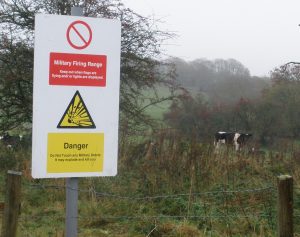The quotidian aspects of the nuclear industries have been described as the ‘banality’ of the nuclear by Gabrielle Hecht and Joe Masco – both writing pre-Trump. ‘Banal’ is not to be confused with ‘safe’. It is a category that describes the ways in which nuclear materials are handled, considered, regulated, familiarised, how they are made ordinary. The banality of the weapons indicates that they have attained ambiguous and contested layers of social meaning; they are not entirely hazard, not entirely benign.
On the Solway, the banality is not only to do with industries and the social forces that hold them in place, but to do with the everyday presence of the uranium in the sea. Because there is no immediate evidence, it has to be remembered, or forgotten, and both require cultural work.

from a public road on the Kirkcudbright Training Area
The DU firings from the Kirkcudbright Training Area (and the land-firings from the base at Eskmeals) may not have that quality of exceptional destruction that is an ontological marker for the nuclear. If not exceptional, then DU weapons could be seen as, what has been newly coined by the US administration, ‘useable’ nuclear weapons. Although not fissionable, their releases and effects are supposedly confined.
DU firings can be regarded as not hazardous for many reasons. Because the uranium is fractionally less radioactive. Because the population affected by the radiation is insignificant – whether that population is human or other-than-human. Or because the measurement of radiation released is calibrated to show ‘safe’ levels, in the present time or place, for a generic human – usually a young adult male. Or because the nuclear weapon is classed as a military necessity. These are views that align with government policy and the nuclear industry, and depending on one’s position, contentious, justified or convenient.
As hazardous qualities diminish, whether because protective measures have been taken or whether the metrics and perceptions define them away, the weapons can become bland commodities, saleable and tradeable, part of the shifting commercial and political values of uranium and arms.
The quotidian aspects of the nuclear industries have been described as the ‘banality’ of the nuclear by Gabrielle Hecht and Joe Masco – both writing pre-Trump. ‘Banal’ is not to be confused with ‘safe’. It is a category that describes the ways in which nuclear materials are handled, considered, regulated, familiarised, how they are made ordinary. The banality of the weapons indicates that they have attained ambiguous and contested layers of social meaning; they are not entirely hazard, not entirely benign.
Hecht’s version of banality is part of her theorisation of ‘nuclearity’, and is derives from investigating uranium mining in Africa, studying whose hands and whose bodies touch the materials, raw and manufactured, and studying the global trade in uranium as commodity and as indicator of military and nation-state status.
Masco writes about the invisibility of the US nuclear arsenal and the ongoing daily machinations of the American nuclear complex. The constancy with which nuclear exceptionalism has been articulated has enabled the erasure of the nuclear economy from public view as too distressing, and at the same time, the ‘banalisation’ of nuclear weapons in everyday life. The nuclear complex becomes visible only in moments of anxiety and crisis. This results in its not being subject to assessment and investigation but to ‘increased fortification’. Masco (2006) pp4-5.
Evidence of the banality of the DU weapons runs throughout the DUFERC minutes, the committee set up to consider the environmental effects of these firings. Too, there is a banality engendered by the constancy with which all kinds of munitions and waste have been fired into the sea. Or by the familiarity and intimate knowledge for handling, storing and transporting uranium necessary for the nuclear industry, a familiarity spreading, like a tide, from the south. Or because these weapons are ‘useable’, and used, needing test fires and rehearsals.
The firings in the Solway are now public knowledge; and from what is known, they probably do not at present, for the human populations, warrant extreme anxiety over immediate safety. But as everyday occurrences, they have made visible some of the structures and practices of the civil-military nuclear industries.
To attribute a banality to the firings is not to fix them into an acceptable, tolerable range of actions towards the sea. To find a banality to them is in no way to allow these actions to be normalised.
Instead, exposing a banality allows the possibility that reassessments might be done regarding the ordinary functions of government, corporate and Military bureaucracies as regards the use of land and sea for nuclear firings; as regards commercial secrecy and international trade and the criteria for safety and for sanctuary – reassessments made a step away from the nuclear extreme, by those whose lives touch the sea, and by thinkers, artists, speakers on any part of the island. The firings on the Solway are events to think with, and contest.
On the Solway, the banality is not only to do with industry and the social forces that hold it in place, but to do with the everyday presence of the uranium in the sea. Because there is no immediate evidence, it has to be remembered, or forgotten, and both require cultural work. Because its presence is as constant as the tides, as far as can be known. Because in the sea, there is no escape from the corroding metals, at least not for the life forms nearest to them. There is no regime of handling and protection, no ‘safe place’.
Hecht, Gabrielle (2012) Being Nuclear. Africans and the Global Uranium Trade. London: The MIT Press.
Masco, Joseph (2006) The Nuclear Borderlands. The Manhattan Project in Post-Cold War New Mexico. Oxford: Princeton University Press.


